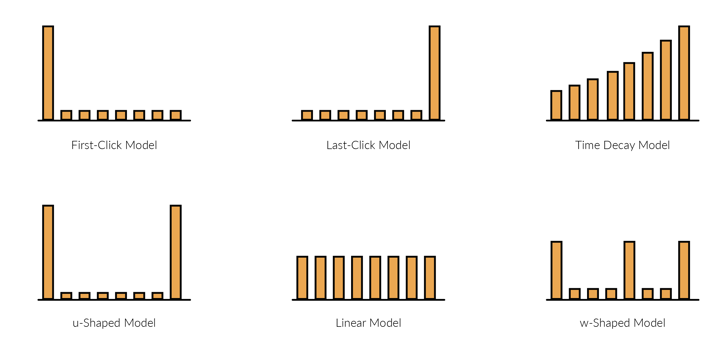The digital marketing landscape is one of endless opportunities. With an ever-growing set of tools and platforms to choose from, there is no shortage of ways to reach your audience, and, if you do it right, turn the anonymous user into a valuable customer. However, with the customer journey being a complex ecosystem filled with campaigns, ads and messages, how can you accurately give credit where credit is due? How do you know where to double-down your efforts and where to hold back?
Attribution is the million dollar question, and getting it right is definitely not straightforward.
So here are five things we think about at Funnel when we think about marketing attribution.
1. Is our tracking setup in order?
A proper tracking setup is the foundation of modern digital marketing, and therefore it’s crucial for doing attribution right. Platforms like Facebook, Google, and LinkedIn will give you a head start and have quick guides on how to install their tracking pixels. These are great, but they will only pass data to the respective platform and that is not enough. Since we are looking for a way to get the big picture and connect multiple touch-points, we need something that creates a common thread through all our marketing efforts.
The way we solved things at Funnel was to add a couple of lines of code to our website that generate a unique identifier to every user, that is then is passed both to Google Analytics and HubSpot (our CRM). With this unique identifier we can start mapping top of the funnel activities like page views with real business goals like, did the lead that booked a meeting go on to participate in a trial? And even further, did that deal close?

Note: privacy laws are definitely a hot topic amongst marketers, with the GDPR maybe being the one that affects us most. Be mindful of these laws before setting your tracking.
2. Is our data clean?
The problem marketers face is not the lack of data, but how messy their data is. So it’s crucial to make sure your data is cleaned, mapped and organised as soon as it’s collected. Luckily, we have access to Funnel, and by using the solution we can easily link the unique ID in several platforms, clean occasional campaign name issues, and map CRM and sales data together.
Also read: What you need to know about multi touch attribution.
Although Funnel will automatically aggregate cost, clicks, impressions and the most top of the funnel metrics, you should always pay attention to the conversions. Remember that every platform will count conversions differently and may have different attribution windows. By just summing all the conversions from all your platforms you will most likely end up with a bigger number than what you really have. For that reason, it’s good to decide on a conversion source of truth -- that will be your north star. At Funnel we use HubSpot data, but in most cases Google Analytics will also be accurate.
3. What Attribution Model Should We Use?
There is no universally correct attribution model. Each marketer has their own preferences, and every business model has a particular sales process that will most likely impact which model you choose, but it’s always good to know there are different ways you can approach attribution. Here are some of the most common models out there:
1. First Click AttributionAll the credit goes to the channel that got the first click of that particular user.
2. Last Click Attribution
As you might have guessed, in this case 100% of the conversion goes to the last click prior to the conversion.
The models get a bit more complex from now.
3. Time Decay Attribution
In time decay interactions that are closer to the conversion get more credit. It'll depend on your attribution window and number of interactions, so there is no exact distribution %.
4. U-Shaped Attribution
In this attribution model, 40% of the credit is given to the channels that generated the first click, 40% to the one that ended in a created lead, and the remaining 20% is given to the rest of the channels, if any.
5. Linear Attribution Model
Again a simple model: the credit is given to every channel in the process, equally. There is no weight associated with steps in the buying process.
6. W-Shaped Attribution Model
This model assumes 3 big steps in the buying process: the first visit, the lead creation, and the deal creation. Each of those get 30% of the conversion, while the remaining 10% is split equally among any other interaction along the way.
The main takeaway here is that no model is intrinsically better than the others. It’s the marketers job to test and understand what makes more sense for their reality.

4. Where should we analyse this data ?
Your data needs to live somewhere where it can be analyzed and visualized, and there are plenty of tools for that. Here at Funnel we use Looker, which is a powerful BI tool. Google Data Studio is also a good option, and doesn’t require any programming skills. Sometimes Excel or Google Sheets will do the trick, but data sets usually become too big for them. In the end, the best tool is the one that your team is most comfortable with.
5. What do we do with the information?
The end game of all of this is to feedback the information to your marketing activities. That is, to understand what levers you can pull to reach your business objectives, and having a database that includes data from different sources in various moments of the customer journey allows you to understand what is working at the top of the funnel and what is really bringing cash to the table.

It’s up to you to understand what makes sense and what doesn’t, after all, when it comes to your business you are the expert.
Final Thoughts
As we mentioned, attribution is a big challenge for marketers all around, and to create a logic that works for your business is a tricky thing. We don’t have an answer for that, and we are currently experimenting with different models and ways of approaching it. But maybe this is the key lesson: all you need to do is put in the effort and dive deep to find out what works.
HERE is a checklist we’ve created that covers our process. Feel free to download and let us know how it goes for you!
